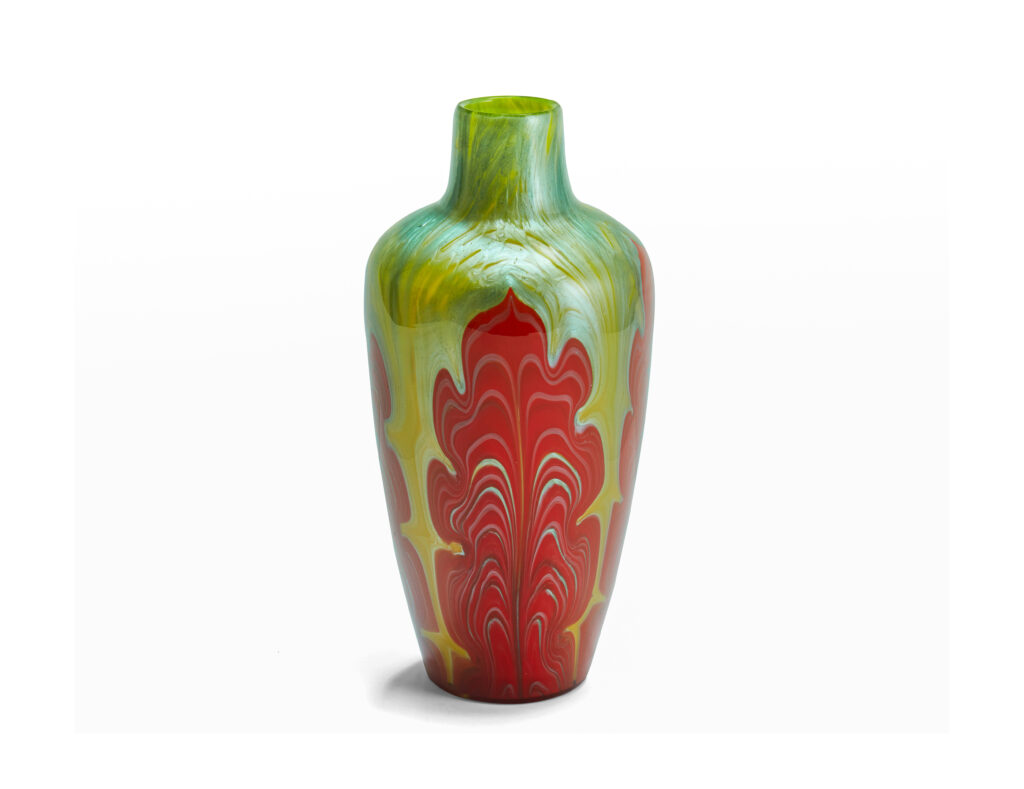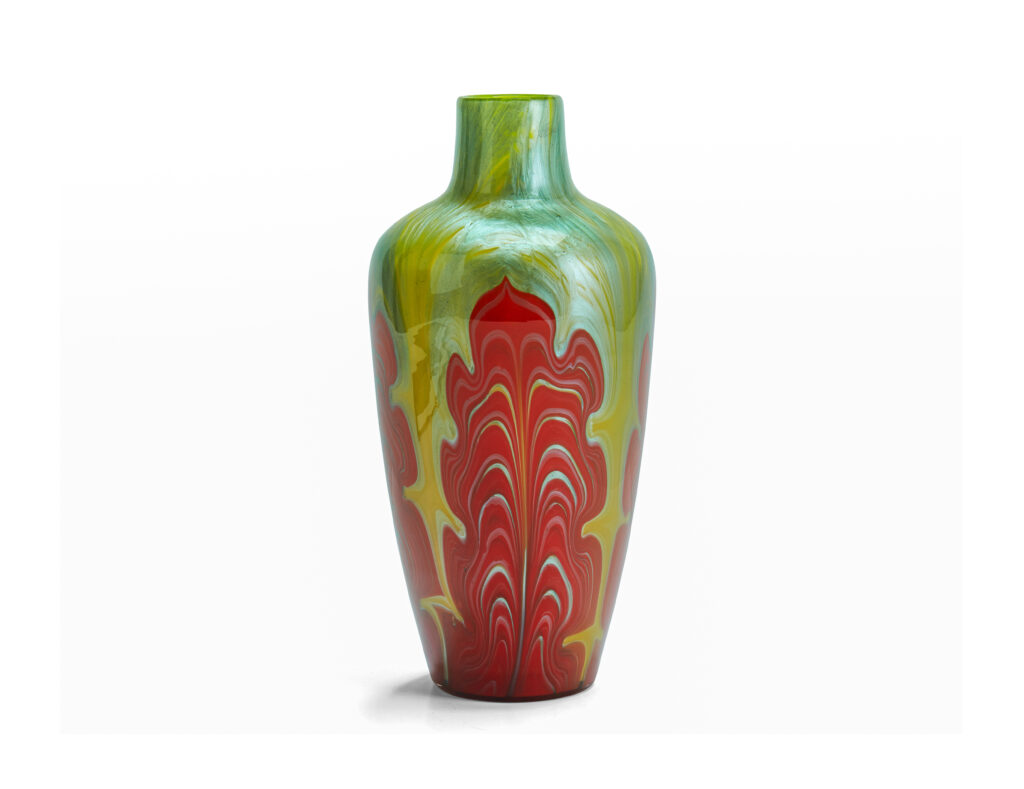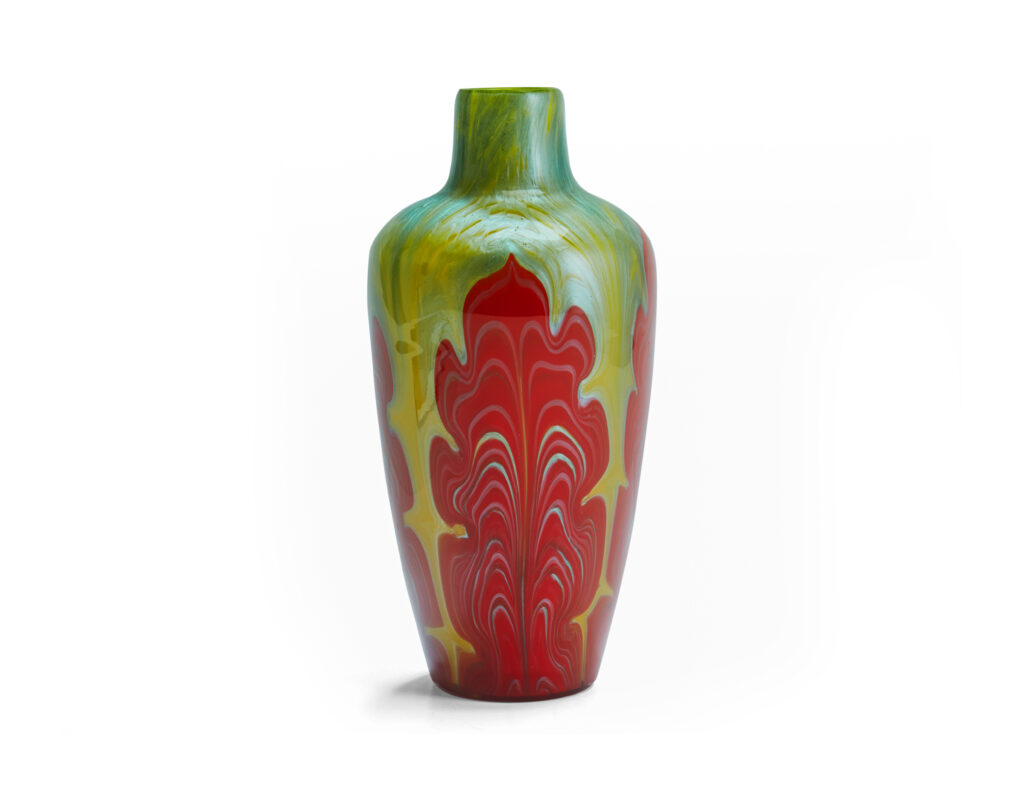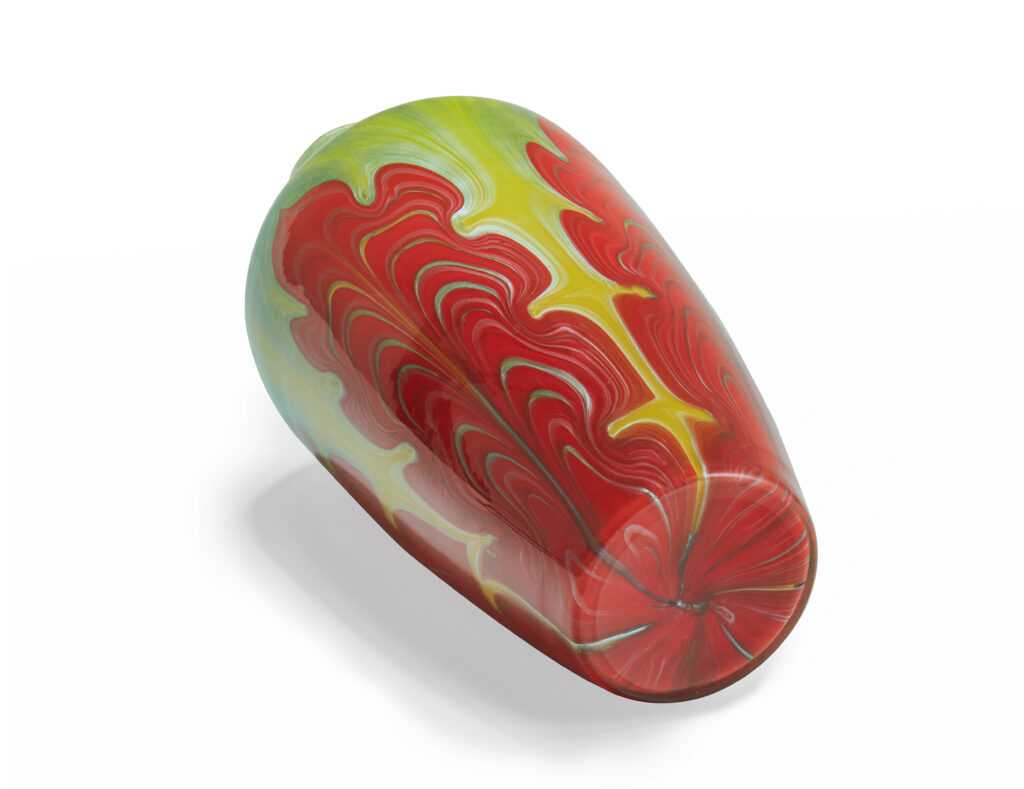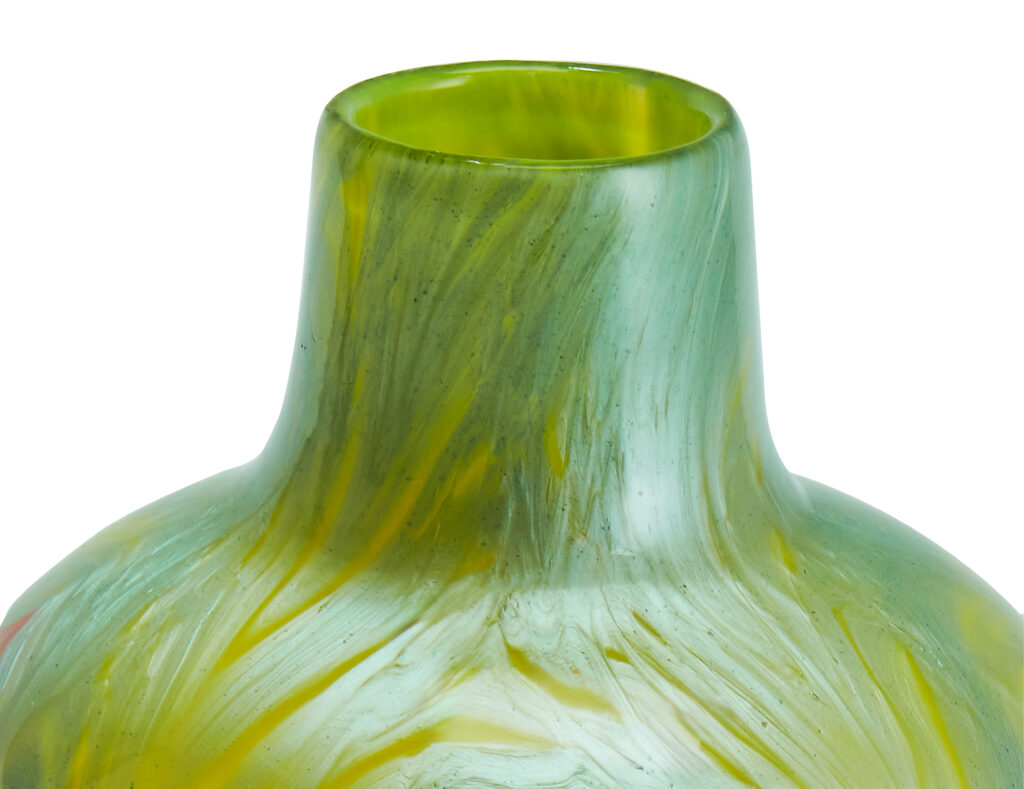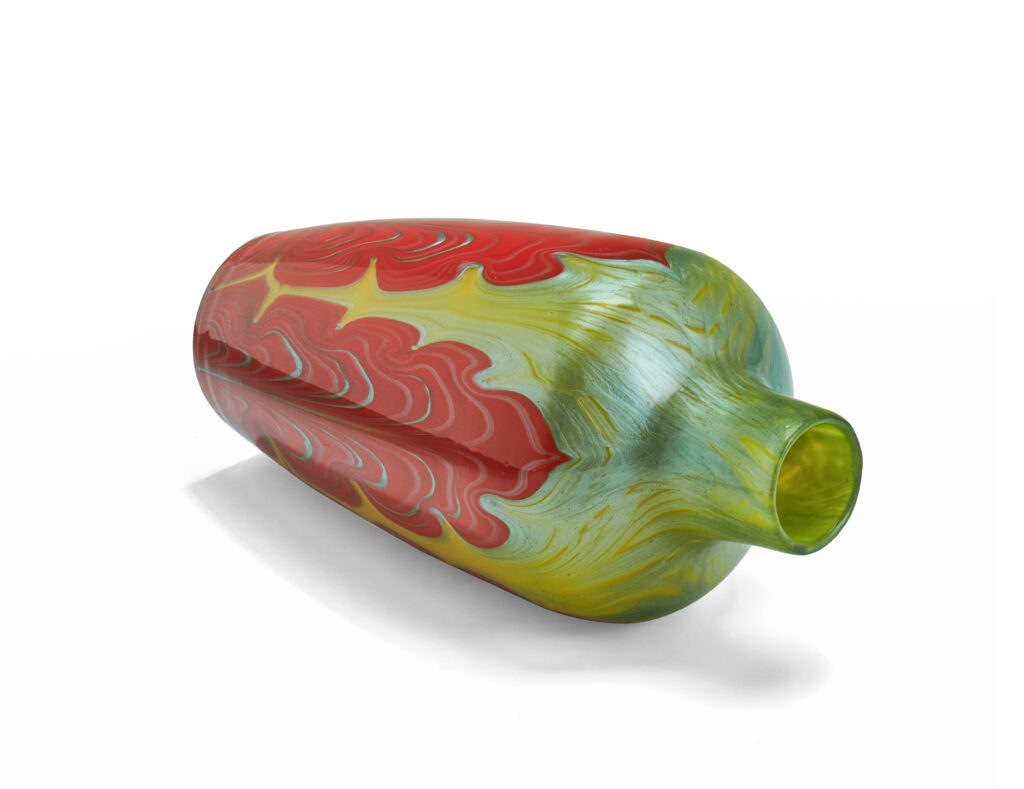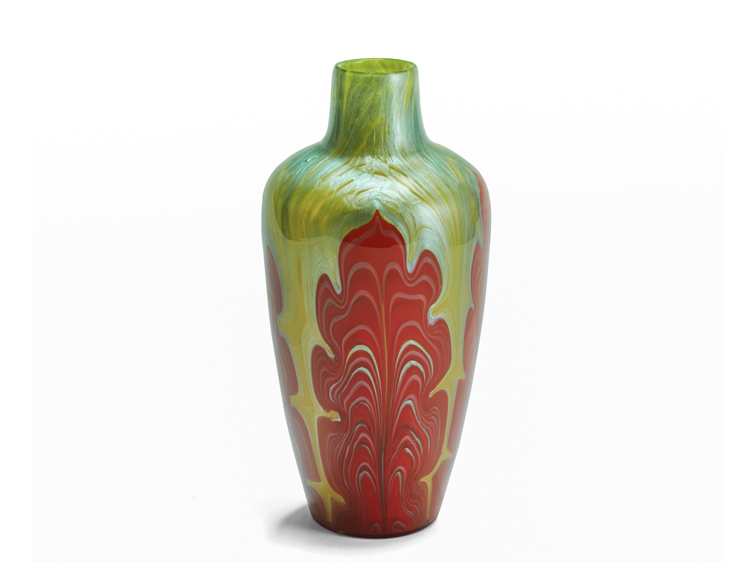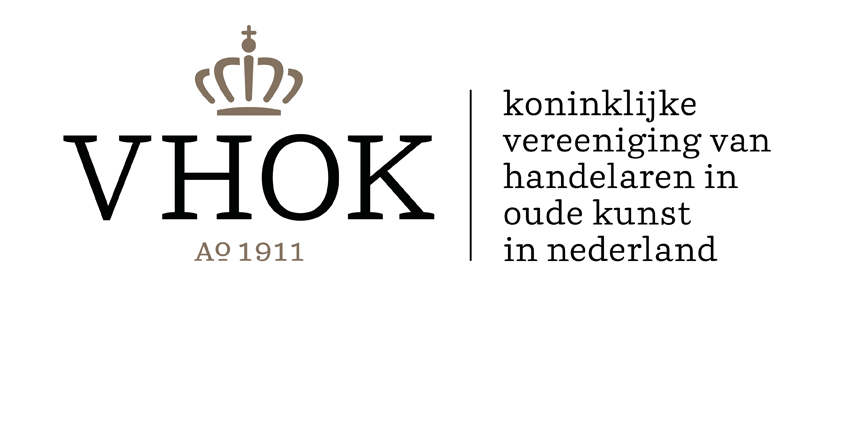Description:
Johann Loetz Witwe, often referred to simply as Loetz or Lötz, was a distinguished glass manufacturer renowned for its exceptional artistry and innovative techniques during the Art Nouveau period. The company was founded in 1836 in the Bohemian region, now part of the Czech Republic, and it became a leading figure in the decorative arts by the late 19th and early 20th centuries. Under the visionary leadership of Max Ritter von Spaun, Loetz pushed the boundaries of glassmaking, creating stunning pieces that are still celebrated today for their vibrant colors, intricate patterns, and unique iridescent finishes.
The Introduction of Titania Glass:
By the early 1900s, the interest in the metallic iridescent decor that had defined much of the Art Nouveau glasswork began to wane. In response to this shift in tastes, the Loetz glassworks sought new avenues for surface decoration. Around 1904, the company began experimenting with new techniques that involved both traditional methods and novel combinations of materials. These explorations led to the introduction of several new glass types, one of the most significant being Titania glass, introduced in 1905.
Titania glass was notable for its complex structure, often consisting of multiple layers of glass in contrasting colors, combined with intricate surface decorations applied directly at the furnace. The Titania series frequently employed opalescent and semi-opaque color schemes, which were often embellished with silver-grey (referred to as “stahlgrau” or steel-grey) threads that were wound around the glass and combed into patterns. After a process of intermediate reduction to achieve a metallic sheen, a final layer of colorless glass would be added to encapsulate the design, giving the pieces their distinctive lustrous finish.
Titania Genre 6388 vase
The Titania Genre 6388 vase is a prime example of Loetz’s mastery in glass art, showcasing the sophisticated techniques and artistic vision that made the company famous. The design of the shape of this vase was created in 1907, while the Titania Genre 6388 itself was introduced in 1909. This vase embodies the elegance and innovation that define the Titania series.
Design and Execution:
- Color and Material: The vase is crafted with a ground color of lemon-yellow glass, serving as a bright and cheerful base that immediately draws the eye. The lemon-yellow hue is carefully chosen and controlled during the glassmaking process to ensure a consistent and vibrant tone. This base layer is the foundation upon which the vase’s complex design is built.
- Decorative Layer and Glass Structure: The vase is a stunning example of the intricate craftsmanship that defines the Titania series. It is composed of several layers of glass, beginning with a lemon-yellow inner ground that serves as a bright and cheerful base. Over this base, a striking imperial red leaf motif is applied, creating a captivating visual effect. This decorative element is further enhanced by the presence of steel-gray glass threads, which are meticulously layered to add texture and depth to the design. The interplay between the bold red leaf, the soft yellow base, and the steel-gray threading creates a dynamic contrast of colors and textures, exemplifying the highest quality of the Titania genre. To complete the piece, an outer casing of colorless glass envelops the entire vase, providing a smooth and glossy finish that enhances the visual impact of the vibrant colors beneath. This sophisticated layering and the expert use of color and texture are a testament to the skill and creativity of Loetz artisans, making this vase a truly remarkable work of art.
- Iridescence: Although the Titania series is not primarily known for iridescence, this vase subtly incorporates this effect, enhancing the surface with a delicate sheen that shifts in different lighting conditions.
Condition and Details:
In addition to its remarkable features, it should be noted that there are some very fine scratches at the neck of the vase. These scratches are most likely the result of the manufacturing process and do not detract from the overall beauty and integrity of the piece. Such minor imperfections are common in handmade glassworks of this era and further emphasize the artisanal nature of its creation.
The vase also features a beautifully improved pontil, indicative of its high-quality craftsmanship. The pontil mark, often left after the glassblowing process, has been meticulously polished, ensuring that the vase stands smoothly and without any imperfections at its base. This attention to detail is a clear sign of the vase’s superior quality and the expertise of its makers.
Like many Loetz pieces from this period, the Titania Genre 6388 vase is unsigned. However, its distinctive style, quality, technique, and design make it easily identifiable as a product of Johann Loetz Witwe, particularly within the Titania series.
Design and Cataloging:
The design of the Titania Genre 6388 vase is documented in the literature as Series II 5165, a shape developed in 1907 that served as the basis for many exquisite Titania genres. This series is noted for its use of bold color contrasts and intricate layering, elements that are clearly evident in this vase. Among the various executions of the Titania Genre 6388, this particular example stands out as one of the finest. The exceptional quality of its color contrasts, the precision of its intricate layering, and the overall craftsmanship make this vase a truly remarkable piece. Although unsigned, the vase’s design, materials, and craftsmanship firmly establish its provenance and place within the Loetz oeuvre.
Historical and Artistic Context:
Titania glass was one of several innovative glass types introduced by Loetz during the early 1900s as the company sought to maintain its leading position in the luxury glass market. Alongside other glass types such as Ophir and Metallin, Titania represented a shift towards more complex and visually striking designs that moved away from the heavily iridescent finishes of the previous decade. Titania glass, in particular, drew comparisons to the paperweight techniques of earlier periods due to its intricate layering and surface decoration, which created a sense of depth and complexity that was both modern and reminiscent of classical glass art.
In summary, the Titania Genre 6388 vase is a quintessential example of Loetz’s innovative approach to glassmaking. Its striking color contrasts, complex layering, and meticulous craftsmanship make it a treasured piece of art, reflecting the height of Bohemian glassmaking during the early 20th century. Whether viewed as a standalone work or as part of the broader Titania series, this vase exemplifies the enduring legacy of Johann Loetz Witwe and the artistic evolution that took place within the company during this period.
